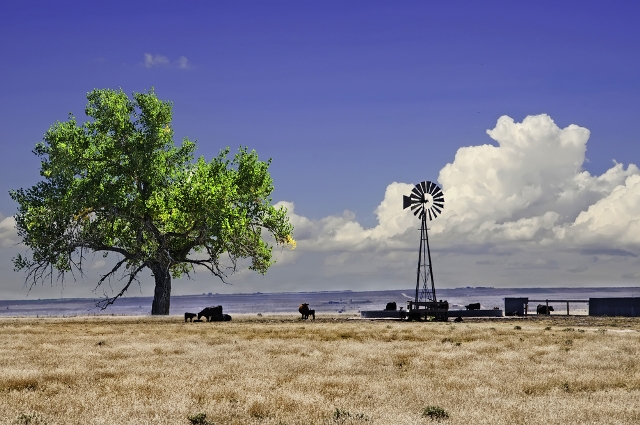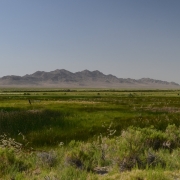Could Insurance Markets Help Water Utilities Respond to Drought?
Drought restrictions and wet summers shake utility budgets. Researchers propose a new financial tool.
By Brett Walton
Circle of Blue
Last Friday, the California Water Resources Control Board extended for eight months an emergency water conservation mandate that Governor Jerry Brown first ordered on April 1, 2015. The goal of the regulation, issued in response to California’s worst-ever drought, was to reduce urban water use by 25 percent compared to 2013, a year before water reserves began to plummet.
By and large, the mandate worked. Californians, despite bristling at the top-down order, followed the governor’s directive. Through November, the 411 urban water suppliers that are covered by the regulation had reduced water use by 26 percent. Homeowners tore out lawns, stopped washing cars, and took shorter showers, all in a collective effort to respond to the drought.
“Almost everyone in California had a steep water rate increase to respond to declining sales.”
–Andrew Ward,
Fitch Ratings
But cutting water use resulted in undesirable consequences for water utilities. Because they were selling less of their product — and for cities that were ordered to reduce water use by 36 percent, selling much less — utilities suddenly had a revenue problem. Their costs remained relatively stable, but they were taking in less money.
In total, California water agencies were expected to lose between $US 500 million and $US 600 million in net revenue because of the mandated restrictions, according to an economic analysis prepared last May for the State Water Board.
“Almost everyone in California had a steep water rate increase to respond to declining sales,” said Andrew Ward, director at Fitch Ratings, which analyzes water utility finances. In an August survey, nearly eight in 10 water utilities said they planned a rate increase in the following year in response to the drought.
It is not just California. In 2010, the water utility for Austin, Texas, had a $US 53 million budget shortfall after an unusually rainy summer.
Utilities need to change their business models to adapt to 21st-century conditions. In an era of conservation, argues Greg Characklis, water utilities must become more sophisticated financial managers. One way they are doing this is by changing their rate structures so that they earn more revenue from “fixed” fees that do not fluctuate with the amount of water sold.
Characklis, a professor in the department of environmental sciences and engineering at the University of North Carolina, Chapel Hill, has another idea: insurance markets. Farmers buy crop insurance to protect against unpredictable weather and drivers purchase accident protection, but no similar product exists for water utilities. Characklis and his colleagues are assessing the viability of the new financial tool.
Financial Tools to Respond
For most of the 20th century, water utilities responded to scarcity and drought by building larger reservoirs and tapping distant rivers. The storage capacity behind dams allowed for an unrestrained flow of water, even in dry times. Those days are gone. New management methods are gaining prominence, above all conservation.
Conservation reduces long-term costs — utilities do not have to shoulder the capital, operation, and maintenance cost of a big new reservoir. But it also introduces more financial instability, Characklis explained. The way utilities earn money is, on the whole, stuck in the past, reliant on water sales for the lion’s share of revenue.
Revenue insurance would work like other insurance schemes. Utilities would pay a monthly premium based on the level of risk they are willing to assume. If revenue losses go beyond a certain threshold, the utility would receive a cash payout. Both hydrological extremes could be accounted for — drought as well as deluge.
Observers are intrigued by the concept.
“It’s definitely an interesting idea,” Ward, of Fitch Ratings, told Circle of Blue. “It does get at one of the key challenges for water managers, which is the volatility of revenue and weather and the mismatch between costs.”
Revenue, weather, and costs. The three are related. Utilities earn most of their revenue by selling water. The exact amounts differ for each utility, but a rule of thumb is that 80 percent of revenue comes from water sales. Sales, in turn, are affected by the weather. Because most residential water is used on lawns, a wet summer can depress demand. A dry year, by contrast, can trigger restrictions, also cutting into revenue.
Revenue variability is a problem, Ward explained, because expenses are not variable. On average, 80 percent of a utility’s costs — the money required to maintain pipes and treatment plants and pay down debt — are fixed. They do not change.
Utilities usually manage this mismatch in several ways. They keep cash reserves on hand to use during lean times. In drought, they can raise rates or add surcharges, as happened in California. Or they can make structural changes to their rates, shifting revenue from variable to fixed fees. This is what Austin, Texas, is doing. If utilities do not take these actions, their credit rating can be downgraded, resulting in a higher borrowing cost. (Ward said that Fitch has not downgraded any California water utility because of the drought.)
Each response has a drawback, though. Cash reserves are a tempting pot of money for politicians. Raising rates nearly always draws public ire, as customers pay more per unit even as they are told to use less. And increasing fixed fees brings questions of equity and protecting the poor.
Insurance would not eliminate the need for other tools, but it would reduce a utility’s reliance on any particular one.
“All of these responses — surcharges, rate changes, reserve funds — are complimentary,” Characklis said. “Utilities can use them to deal with less severe to moderate droughts, but use insurance for extreme drought.”
Still Testing the Recipe
The insurance concept is still a work-in-progress. Three significant questions remain:
- What is the best measurement for determining when a payout should be made? Characklis said that rainfall, streamflow, and other weather indexes do not necessarily correlate with financial strain if utilities have large reservoirs or bring water from afar.
- How many utilities need to be included in the risk pool? Insurance markets are more sustainable with a larger number of participants because the cost is shared. “You don’t want everyone suffering at the same time,” Characklis explained.
- How geographically dispersed should they be? This is similar to the second question. Including cities from all corners of the country helps ensure that a severe drought in one area does not wipe out the entire insurance fund. It is unlikely that cities in California, Ohio, Texas, and Virginia would all simultaneously file claims.
Characklis said there is keen interest from California water agencies. He has not yet approached any insurers.
The appeal of revenue insurance, however, will vary for each city. Santa Barbara, for instance, could end the year with a $US 2 million revenue shortfall, according to Joshua Haggmark, the water resources manager. But because Santa Barbara has money in the bank, he did not foresee a need for another financial tool.
“I don’t see it as being something we can’t work out,” Haggmark told Circle of Blue, referring to the drop in revenue. “We have a big reserve balance. We keep roughly $US 18 million in reserve, which we’ve been tapping into.”
Haggmark acknowledged that not all utilities are in such a position.
“Other communities might not have the public support to have that much in reserve,” he said.
Brett writes about agriculture, energy, infrastructure, and the politics and economics of water in the United States. He also writes the Federal Water Tap, Circle of Blue’s weekly digest of U.S. government water news. He is the winner of two Society of Environmental Journalists reporting awards, one of the top honors in American environmental journalism: first place for explanatory reporting for a series on septic system pollution in the United States(2016) and third place for beat reporting in a small market (2014). He received the Sierra Club’s Distinguished Service Award in 2018. Brett lives in Seattle, where he hikes the mountains and bakes pies. Contact Brett Walton












Leave a Reply
Want to join the discussion?Feel free to contribute!